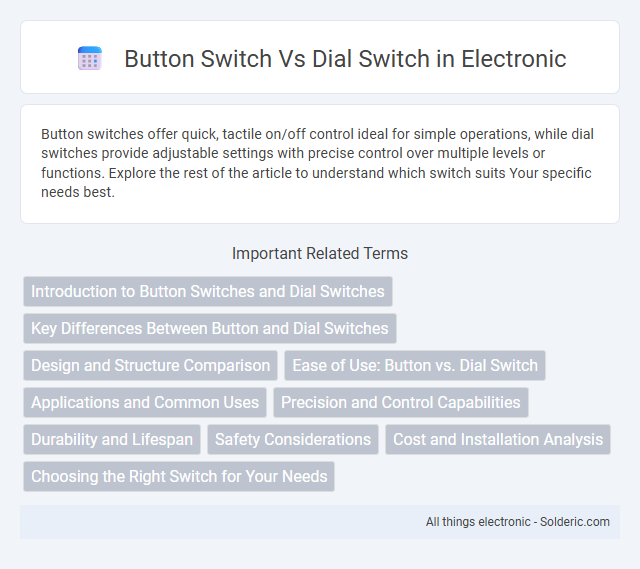Button switches offer quick, tactile on/off control ideal for simple operations, while dial switches provide adjustable settings with precise control over multiple levels or functions. Explore the rest of the article to understand which switch suits Your specific needs best.
Comparison Table
| Feature | Button Switch | Dial Switch |
|---|---|---|
| Operation | Press to toggle or momentary action | Rotate to select setting or adjust level |
| Control Type | Discrete On/Off or momentary | Continuous or stepped variable control |
| Use Case | Simple toggles, resets, or inputs | Volume, temperature, or multi-level adjustments |
| Size & Space | Compact, minimal panel space | Larger, requires more panel space |
| User Feedback | Tactile click or visual LED indicator | Visual position indicators or markings |
| Durability | High, fewer mechanical parts | Moderate, more moving components |
| Installation | Simple wiring, quick installation | Requires precise alignment and calibration |
| Cost | Generally lower cost | Typically higher cost |
Introduction to Button Switches and Dial Switches
Button switches and dial switches serve distinct functions in electronic devices, with button switches providing quick, momentary on/off control through a simple press mechanism. Dial switches offer precise adjustment by rotating a knob to select from multiple settings or levels, ideal for variable control such as volume or temperature. Your choice between these switches depends on the need for either immediate toggling with a button or fine-tuned adjustments using a dial.
Key Differences Between Button and Dial Switches
Button switches provide discrete on/off functionality with a simple press, making them ideal for quick, tactile control events, while dial switches offer variable control by rotating through multiple positions or continuous settings. Button switches generally feature a momentary or toggle mechanism with binary states, whereas dial switches enable precise adjustments in settings such as volume, temperature, or speed through graduated increments. The physical design and user interaction differ notably: buttons emphasize speed and simplicity, while dials prioritize range and fine-tuning.
Design and Structure Comparison
Button switches feature a compact, flat design with distinct tactile feedback through a push mechanism, making them ideal for precise on/off control in compact spaces. Dial switches incorporate a rotary design that allows continuous adjustment across multiple settings, often with visual indicators around the dial for intuitive control. The structural difference lies in the linear vs. rotational movement, affecting user interaction and suitability for varied applications.
Ease of Use: Button vs. Dial Switch
Button switches offer straightforward operation with quick, tactile feedback, making them ideal for users seeking simple and immediate control. Dial switches provide precise adjustment through incremental turning, which benefits tasks requiring fine-tuned settings but may demand more attention during use. Your choice depends on whether ease of use favors quick activation or gradual control accuracy.
Applications and Common Uses
Button switches are commonly used in electronic devices requiring precise, momentary activation, such as remote controls, calculators, and computer keyboards. Dial switches are preferred in applications demanding variable control settings, like volume adjustment, temperature regulation, and industrial machinery controls. Your choice between button and dial switches depends on whether the application needs quick toggling or adjustable, continuous control.
Precision and Control Capabilities
Button switches offer discrete, tactile feedback allowing users to execute precise on/off commands rapidly, making them ideal for digital control tasks. Dial switches provide adjustable, continuous control over a range of settings, granting You nuanced manipulation suited for applications requiring fine-tuning. Selecting between these depends on whether your priority lies in exact, immediate toggles or gradual, variable adjustments.
Durability and Lifespan
Button switches typically offer higher durability due to their simple mechanical design, often rated for over 1 million cycles, making them ideal for frequent use in industrial and consumer electronics. Dial switches, while providing precise control, generally have a lower lifespan, usually around 100,000 cycles, because of their complex rotary mechanism which is more prone to wear and tear. Choosing between button and dial switches depends on the application's demand for longevity and the intended frequency of operation.
Safety Considerations
Button switches offer improved safety due to their momentary contact design, reducing the risk of accidental activation compared to dial switches which maintain continuous contact and can unintentionally stay in the "on" position. Dial switches may pose higher electrical hazards if their position is misaligned or if the user mistakenly leaves the device powered, increasing the chance of electric shock or equipment damage. Your choice of switch should prioritize reliable control and prevention of unintended operation to enhance safety in your electrical systems.
Cost and Installation Analysis
Button switches generally offer a lower upfront cost compared to dial switches, making them a budget-friendly choice for simple electrical applications. Installation of button switches is typically straightforward due to their compact design and fewer components, reducing labor time and costs. Your decision may hinge on balancing these savings against the more customizable settings and potential complexity offered by dial switches.
Choosing the Right Switch for Your Needs
Button switches provide precise, momentary control ideal for applications requiring quick, tactile input, while dial switches offer adjustable, continuous settings suitable for volume or intensity control. Evaluate the required user interaction, space constraints, and desired feedback when selecting between button and dial switches. Consider the environment and durability needs to ensure optimal performance and longevity of the chosen switch type.
button switch vs dial switch Infographic

 solderic.com
solderic.com